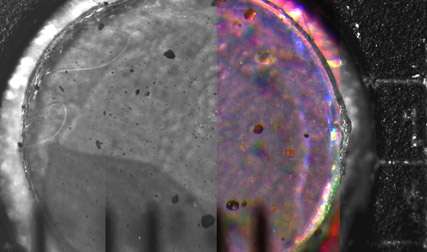Image credit: NASA/JPL-Caltech/University of Arizona
This mosaic of four side-by-side microscope images shows a 3 millimeter (0.12 inch) diameter silicone target after it has been exposed to dust kicked up by the landing. It is the highest resolution image of dust and sand ever acquired on Mars.
This mosaic of four side-by-side microscope images (one a color composite) was acquired by the Optical Microscope, a part of the Microscopy, Electrochemistry, and Conductivity Analyzer (MECA) instrument suite on NASA's Phoenix Mars Lander.
Taken on the ninth Martian day of the mission, or Sol 9 (June 3, 2008), the image shows a 3 millimeter (0.12 inch) diameter silicone target after it has been exposed to dust kicked up by the landing. It is the highest resolution image of dust and sand ever acquired on Mars. The silicone substrate provides a sticky surface for holding the particles to be examined by the microscope.
The Phoenix Mission is led by the University of Arizona, Tucson, on behalf of NASA. Project management of the mission is by NASA's Jet Propulsion Laboratory, Pasadena, Calif. Spacecraft development is by Lockheed Martin Space Systems, Denver.
Source: NASA
























